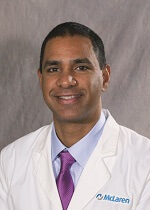
Thanks to advanced heart monitoring technology at McLaren Macomb, a patient experiencing sudden cardiac arrest at home was revived after 47 seconds with no heartbeat.
"I should have been dead," Tony Widick said. "I couldn't ask for better docs."
It was Christmas, but Clinton Township resident Widick's mind was preoccupied. For several days, he had been experiencing persistent, worsening chest pain, hurting to the point it became difficult to perform routine activities and now he was having trouble sleeping.
 "I was thinking, "˜This isn't right,' " Tony said.
"I was thinking, "˜This isn't right,' " Tony said.
Tony's pain became so intense that he was having difficulty breathing, forcing his wife to call an ambulance, taking him to the emergency department at McLaren Macomb. After quickly determining that Tony was having an acute heart attack, he was immediately met by Dr. Sibin Zacharias, an interventional cardiologist.
Dr. Zacharias performed a cardiac catheterization and opened the blockage with balloon angioplasty, quickly restoring blood flow to the heart muscle. He then placed cardiac stents in the heart's main artery to keep the artery open.
While evaluating Tony's heart, Dr. Zacharias determined that the heart's main pumping chamber had become weakened from the heart attack.
"When the heart is significantly weakened after a heart attack, the patient's risk for sudden cardiac death increases," Dr. Zacharias said. "Time was needed for his heart to heal and for new medications to take effect. But Tony still needed to be monitored and protected for his increased risk of sudden cardiac death."

Tony was outfitted with a LifeVest wearable defibrillator-the first medical device of its kind-that continually monitors the patient's heart rhythm. If the LifeVest detects a life-threatening abnormal heart rhythm, it delivers an electric defibrillating shock to restore normal rhythm.
"At that time, it was too soon to place an implantable, permanent defibrillator," said Dr. M. Cameron Willoughby, a cardiac electrophysiologist with McLaren Macomb. "The decision to provide the patient with LifeVest was the best option we had and his compliance in wearing the device as much as he did was critical."
And Tony credits his doctors and the LifeVest for saving his life.
Just seven days after his heart attack, Tony was sitting at home watching the football games on New Year's Day. He doesn't remember what happened next.

"I was sitting there with my brother," Tony said. "He told me later that I slumped over just sitting there on the couch. He yelled for my wife and they were panicking, not knowing what's happened to me. Next thing I know I'm awake-the vest shocked me back.
"My heart had stopped. I was flat-lined for 47 seconds."
Conscious, Tony was driven to McLaren Macomb and met again by Dr. Zacharias. Tony had suffered ventricular fibrillation, a life-threatening, sudden death condition. He received two more stents to treat residual effects on the heart, and Dr. Willoughby inserted a permanent defibrillator as Tony continues to recover.
Tony credits the ZOLL LifeVest and the physician who prescribed him to wear it with saving his life following his sudden cardiac arrest. The whole episode gave him a renewed interest in his health.
"I have my good days and my bad days," he said. "It's been a life experience-really scary and it gives you a new perspective. But it happened and I'm here. That's what matters."
Learn more about the cardiac care offered at the McLaren Cardiovascular Institute or make an appointment with a cardiologist by visiting mclarenheart.org.